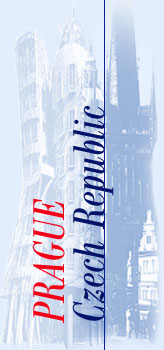EXCURSIONS IN PRAGUE
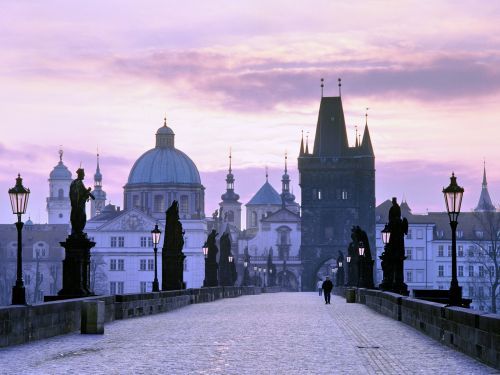 1.1 PRAGUE SIGHTSEEING TOUR - HALF DAY 1.1 PRAGUE SIGHTSEEING TOUR - HALF DAY
Duration: 4 hours: 1/2 hour sightseeing by bus; 3,5hours walking tour.
During this tour you will receive general information about the city itself and you will see the most important sight of Prague. Tour will start with a private transfer to Prague Castle area. The Prague Castle is the most popular sight visited in Prague, its distinctive panorama with St. Vitus’ Cathedral dominates Prague skyline. Today it is the seat of the Czech president. From Prague Castle we head for the river, for a stroll across Charles Bridge, and for more wonderful views of the city. The Charles Bridge is a famous historic bridge that crosses the Vltava river in Prague. It is protected by three bridge towers, two of them on the Lesser Quarter side and the third one on the Old Town side. The bridge is decorated by a continuous alley of 30 statues and statuaries, most of them baroque-style. While walking through the picturesque streets we will reach the Old Town Square and you can admire the impressive composition of old buildings and churches. We also become acquainted with the life of the Czech reformer Jan Hus. The buildings from the Old Town Square are a fortunate collage of architectural styles. The most famous of them all is without doubt the fabulous Astronomical Clock “Orloj” in the Old Town City Hall. After seeing this impressive historical monument, the tour ends here.
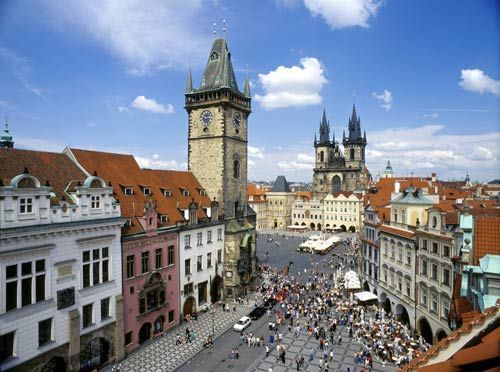 1.2 PRAGUE SIGHTSEEING TOUR - FULL DAY 1.2 PRAGUE SIGHTSEEING TOUR - FULL DAY
Duration: 2x4 hours; 2x1/2 hour sightseeing by bus + 3,5 hours walking tour.
This city tour starts at Wenceslas Square, where you can experience the true buzz of the city life, as this square never sleeps. It’s a perfect place for going shopping, meeting friends or just hanging out, it is in fact one of Prague’s’ favorite meeting places. One could take it for a normal, regular square just like so many others on the planet. But even so, it is already worthwhile seeing - outdoor exhibitions, the tram café, the bronze equestrian statue of St. Wenceslas and the golden cupola of the National Museum dominating the horizon make the square even more interesting. From here we walk to the Republic Square while passing on the way the Municipal house, which is the most spectacular Art Nouveau building in Prague, hosting many concerts and exhibitions and being admired by millions of tourists and visitors. To continue our city tour we will take a transfer from here directly to the Prague Castle area. The Prague Castle is the most popular sight visited in Prague, its distinctive panorama with St. Vitus’ Cathedral dominates Prague skyline. Today it is the seat of the Czech president. Not only the cathedral, the Old Royal Palace, the Picture Gallery, but also extensive gardens, from which you may have wonderful view of the city, are worth seeing. From Prague Castle we head to the river, for a stroll across Charles Bridge, and for more wonderful views of the city. The Charles Bridge is a famous historic bridge that crosses the Vltava river in Prague. It is protected by three bridge towers, two of them on the Lesser Quarter side and the third one on the Old Town side. The bridge is decorated by a continuous alley of 30 statues and statuaries, most of them baroque-style. While walking through the picturesque streets we will reach the Old Town Square and you can admire the impressive composition of old buildings and churches. Here we become acquainted with the life of the Czech reformer Jan Hus. The buildings from the Old Town Square are a fortunate collage of architectural styles. The most famous of them all is without doubt the fabulous Astronomical Clock “Orloj” in the Old Town City Hall. Then we continue our Prague tour with a walk towards Prague’s famous Parizska street, lined with beautiful, elegant buildings, exclusive shopping precinct filled with luxurious designer retail stores. Reaching the Vltava river we will enjoy the last part of today city tour, an one-hour boat trip. From the deck of the boat you will have the most beautiful sights right at the tip of your nose. The boat cruise offers you an original view of the city from the water.
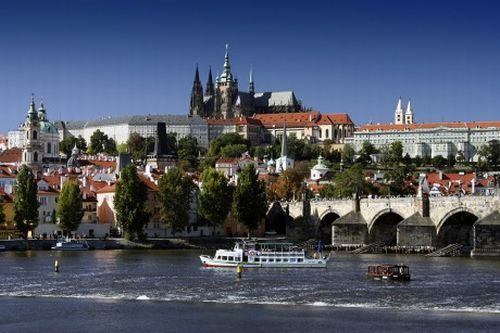 1.3 PRAGUE CASTLE 1.3 PRAGUE CASTLE
Duration: 3 hours.
The Prague Castle, an ancient symbol of the Czech lands, is the most significant Czech monument and one of the most important cultural institutions in the Czech Republic. It is the most popular sight visited in Prague, its distinctive panorama with St. Vitus’ Cathedral dominates Prague skyline. At the ancient times it was the seat of Bohemian kings; today it is the seat of the Czech president. A Unesco World Heritage site, it consists of a large-scale composition of palaces and ecclesiastical buildings of various architectural styles, from Roman-style buildings from the 10th century through Gothic modifications in the 14th century. Since the Velvet Revolution, the Prague Castle has undergone significant and ongoing repairs and reconstructions.
St. Vitus Cathedral is the largest and most important church in Prague, featuring the Gothic tombs of Czech kings or the Chapel of St. Wenceslas, the patron saint of the nation. The Old Royal Palace served as the residence of Czech kings, while St. George Basilica is the oldest religious building in Central Europe. The Daliborka Tower was part of the castle fortifications and it offers a beautiful view of Deer Moat – a wooded ravine where Emperor Rudolf II went to hunt game. Famous Golden Lane is full of colourful little houses with tiny windows and chimneys, until min-20th century craftsmen and artists lived here, including Franz Kafka.
Don’t miss the Changing of Guards including fanfare and flag ceremony, which is held every day at noon in the castle’s first courtyard.
If you want to have the most beautiful view of the Prague Castle complex, climb the 287 steps to the observation deck of the tower of St. Vitus Cathedral. The most beautiful pictures of panorama of Prague Castle can be taken from the Smetana Embankment.
1.4 JEWISH TOWN OF PRAGUE
Duration: 3 hours.
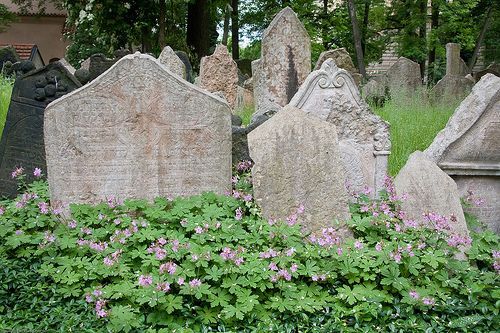 The Jewish Town of Prague, known as Josefov, a centre for Jewish culture since the Middle Ages, is situated in the north-western part of the Old Town. In the late 18th century there were 274 residential houses, 10 synagogues and many public buildings. During urban renewal between 1896-1911, the Jewish quarter was pulled down and replaced with new buildings mostly in Art Nouveau style. Modifications in the Rococo style after 1763 gave the Jewish town hall in Maiselova street its present appearance. The Maisel Synagogue was commissioned by a wealthy primas of the Prague Jewish Community, Mordechai Maisel, nearly five centuries ago, as was the largest synagogue in ghetto, the Klausen Synagogue. In the Pinkas Synagogue, visitors see a very unusual exhibition – more than 4,000 drawings by Jewish children who were interned at the Terezin concentration camp in northern Bohemia, many of whom died at the hands of Nazis. The walls are hand-inscribed with some 80,000 names of Czech Jews who perished under the Nazi regime. At the Old Jewish Cemetery, among 12,000 tombstones you will find the grave of Rabbi Loew, who, according to ancient legend, created an artificial being – the Golem. The building of the former ceremonial hall and charnel house was designed in a pseudo-Romanesque style at the beginning of the 20th century and is now an exhibition venue. The oldest and the most beautiful Jewish temple is the Old-New Synagogue, which boasts massive brick gables. According to the legend, it is in the attic here that the fabled Golem is stowed. The gorgeous Spanish Synagogue stands on the site where Jews from Spain settled when they were expelled by Queen Isabella of Castille in the 15th century. The Jewish Town of Prague, known as Josefov, a centre for Jewish culture since the Middle Ages, is situated in the north-western part of the Old Town. In the late 18th century there were 274 residential houses, 10 synagogues and many public buildings. During urban renewal between 1896-1911, the Jewish quarter was pulled down and replaced with new buildings mostly in Art Nouveau style. Modifications in the Rococo style after 1763 gave the Jewish town hall in Maiselova street its present appearance. The Maisel Synagogue was commissioned by a wealthy primas of the Prague Jewish Community, Mordechai Maisel, nearly five centuries ago, as was the largest synagogue in ghetto, the Klausen Synagogue. In the Pinkas Synagogue, visitors see a very unusual exhibition – more than 4,000 drawings by Jewish children who were interned at the Terezin concentration camp in northern Bohemia, many of whom died at the hands of Nazis. The walls are hand-inscribed with some 80,000 names of Czech Jews who perished under the Nazi regime. At the Old Jewish Cemetery, among 12,000 tombstones you will find the grave of Rabbi Loew, who, according to ancient legend, created an artificial being – the Golem. The building of the former ceremonial hall and charnel house was designed in a pseudo-Romanesque style at the beginning of the 20th century and is now an exhibition venue. The oldest and the most beautiful Jewish temple is the Old-New Synagogue, which boasts massive brick gables. According to the legend, it is in the attic here that the fabled Golem is stowed. The gorgeous Spanish Synagogue stands on the site where Jews from Spain settled when they were expelled by Queen Isabella of Castille in the 15th century.
As many other tourists you can leave a small note with secret wish on the tombstone of Rabbi Loew. It is said that Rabbi can fulfill the pilgrim’s wishes.
1.5 OTHER PLACES OF INTEREST IN PRAGUE
Troja Chateau - Duration: 1 hour
Troja Chateau is situated in Prague’s north-west borough Troja, surrounded by beautiful green and the Vltava River. This Baroque palace was built in 17th century for the Sternberk family and filled with sculptures and frescos. The architect, Jean Baptista Mathey, was inspired by great villas in Italy. The most impressive are the decoration of the interior, the frescos are considered to be one of the best examples of Baroque painting. Nowadays the Chateau is owned by the city of Prague and hosts the 19th century Czech art collections of the City Gallery.
Monastery Brevnov - Duration: 2 hours
Monastery Brevnov was founded in 993 as the first friary in Bohemia; later on it became a monastery of Benedictine monks. Nowadays there is a complex of Baroque buildings which you can visit – the St. Margaret Basilica, the prelate building with the Theresian hall and the Romanesque crypt. Close to the crypt is a memorial of the Battle at the White mountain and the Star Castle.
St. Agnes Convent - Duration. 2 hours
It is one of the oldest Gothic buildings and one of the most significant convents in Bohemia. Complex consists of two buildings – the convent of Poor Clares and a small Franciscan monastery. Today the complex is in possession of National Gallery in Prague and it is hosting exhibition of medieval and early Renaissance art.
Vysehrad - Duration: 2 hours
Head upstream along the Vltava River to a rocky promontory on which rises the old Bohemian royal residence, Vysehrad. It is a place full of history and is surrounded by many legends. From here you will have spectacular view of Prague, and in summer months it comes alive with culture – plays and concerts are held in an open-air theatre.You can visit the chapter of the Church of St. Peter and St. Paul and the National cemetery of Honour here.
Zbraslav - the Hall of the Kings - Duration: 2 hours
10 km from Prague centre on a western river bank you can find a small town Zbraslav where you can visit a chateau which used to be once a rich and important Cistercian Monastery. The Cirstercian Order was at the 13th century the standard bearer of the new Gothic culture and learning. In 1784 it was converted into a baroque chateau that is today hosting National Gallery’s permanent collection of Asian art, with copies of well-known Czech scultures in the gardens.
Park and Lapidarium - Duration: 2 hours
It is a wonderful Park and Exhibition area – composing from many buildings and pavilions, since 1991. Visit Køižík’s Fountain - a one-of-a-kind fountain in Europe where water and stage shows are presented with music by classical as well as modern composers. The historical neo-Renaissance building Lapidarium was built in 1891 based on the design created by architect Antonín Wiehl, who built the Lapidarium at the Prague Exhibition Grounds as a seasonal temporary building for the 1891 General Land Centennial Exhibition. In 1907 it was reconstructed in a baroquish Art Nouveau style and the building was also expanded. There are currently installed National Museum exhibits.
The Infant Jesus of Prague
Visit the Church of Our Lady Victorious, where pilgrims pray to the famous Infant Jesus of Prague for protection, healing and help in conceiving a child. The statuette, which is 47 centimeters high, comes from Spain and portrays Jesus in benediction. In the Church of Our Lady Victorious you can view a collection of gowns in which the Carmelite Nuns dress the Infant Jesus of Prague according to liturgical customs.
1.6 SPECIAL GUIDED TOURS OF PRAGUE
A Walking Tour of Prague Cubism
Take a walk past three of the most beautiful Cubist residential buildings in Prague, designed by architect Josef Chochol and located below Vysehrad. Not far from the Vyton tram is the opulent “Kovarovic Villa”(address- Libusina 3). On the corner of Neklanova and Premyslova streets is a masterpiece of architectural Cubism – a four storey residential building. And beside the tram line leading from the city centre to Podoli below Vysehrad Rock stands the two storey “Triple House”.
Visit the most famous Cubist building, the House at the Black Madonna (Ovocny trh 19), designed Czech by leading Czech architect Josef Gocar. It houses an original Cubist café with beautiful chandeliers and light fixtures and also the Kubista shop where you can buy products such as jewellery, ceramics and light fixtures by designers inspired by this style. Note the Baroque statue of the Black Madonna on the corner of the house, which gave the building the name.
On a walk through the centre of Prague, don’t overlook the unique Cubist lamppost made of artificial stone, metal and glass on Jungmann Square (Jungmannovo namesti). Credited with the preservation of this lamppost was the world-famous Czech architect Jan Kaplicky, who designed such buildings as the Lord’s Media Centre in London.
Communism & Nuclear Bunker Tour
This country has a dark period in its history. The communism was full of paranoia, spying and violence. On this tour you can discover the background and stories from the communist time and experience how would life be in communism cold-war period. Part of the daily life in danger was the fear from a nuclear war. In that case, not everybody would survive, only some. But who and where? The answer to this question lies beneath the ground. Facilities were built, which could be used to hide the civil population and save citizen from the radioactivity brought by nuclear bombs and long range missiles. You will visit real nuclear bunker from 1950’s, situated 16met.-4 floors deep, it was built for up to 5000 people with dozens of rooms and many tunnels. We will try to give you the real story of Velvet Revolution and hopefully, new future….
The Prague Underground Tour
In Czech republic there are not only treasures which are visible on first sight on the streets. Beneath the town is another city. Like many other European cities also Prague has lot of hidden gems and secret places. Some of them are almost 1000 years old. Beneath the town is another city from the past. Under the houses of patricians and palaces of nobilities a whole complex of underground cellars, rooms and labyrinth-like corridors can be revealed. The whole city, mostly in the area of the Old Town is undermined with these historical settings. Many times rebuilt, forgotten and again discovered, these historical undergrounds give an insight into the past, unknown facts and relations and give a picture of the life of a medieval city in the 11th and 12th century. Join us for a visit to one of the most spectacular underground areas in central Europe!
Prague Museums and Galleries
According to your wishes, you can have a guided tour in the national Museum of Prague, Museum of Applied Arts, Lobkowitz Palace, Sternberg Palace etc.
|

